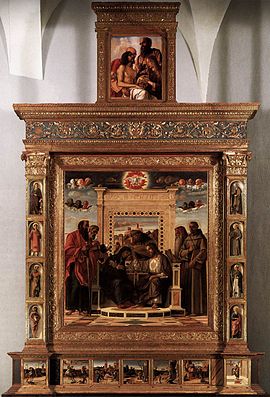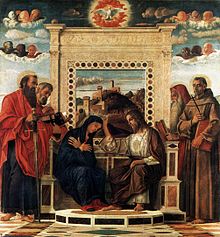
Giovanni Bellini was an Italian Renaissance painter, probably the best known of the Bellini family of Venetian painters. He was raised in the household of Jacopo Bellini, formerly thought to have been his father, but now that familial generational relationship is questioned. An older brother, Gentile Bellini was more highly regarded than Giovanni during his lifetime, but the reverse is true today. His brother-in-law was Andrea Mantegna.

Antonello da Messina, properly Antonello di Giovanni di Antonio, but also called Antonello degli Antoni and Anglicized as Anthony of Messina, was an Italian painter from Messina, active during the Italian Early Renaissance.

BartolomeoMontagna was an Italian Renaissance painter who mainly worked in Vicenza. He also produced works in Venice, Verona, and Padua. He is most famous for his many Madonnas and his works are known for their soft figures and depiction of eccentric marble architecture. He is considered to be heavily influenced by Giovanni Bellini, in whose workshop he might have worked around 1470. Benedetto Montagna, a productive engraver, was his son and pupil and active until about 1540. He was mentioned in Vasari's Lives as a student of Andrea Mantegna but this is widely contested by art historians.

Carlo Crivelli was an Italian Renaissance painter of conservative Late Gothic decorative sensibility, who spent his early years in the Veneto, where he absorbed influences from the Vivarini, Squarcione, and Mantegna. He left the Veneto by 1458 and spent most of the remainder of his career in the March of Ancona, where he developed a distinctive personal style that contrasts with that of his Venetian contemporary Giovanni Bellini.

Pesaro is a comune (municipality) in the Italian region of Marche, capital of the province of Pesaro and Urbino, on the Adriatic Sea. According to the 2011 census, its population was 95,011, making it the second most populous city in the Marche, after Ancona. Pesaro was dubbed the "Cycling City" by the Italian environmentalist association Legambiente in recognition of its extensive network of bicycle paths and promotion of cycling. It is also known as "City of Music", for it is the birthplace of the composer Gioachino Rossini. In 2015 the Italian Government applied for Pesaro to be declared a "Creative City" in UNESCO's World Heritage Sites. In 2017 Pesaro received the European City of Sport award together with Aosta, Cagliari and Vicenza.

The Gallerie dell'Accademia is a museum gallery of pre-19th-century art in Venice, northern Italy. It is housed in the Scuola della Carità on the south bank of the Grand Canal, within the sestiere of Dorsoduro. It was originally the gallery of the Accademia di Belle Arti di Venezia, the art academy of Venice, from which it became independent in 1879, and for which the Ponte dell'Accademia and the Accademia boat landing station for the vaporetto water bus are named. The two institutions remained in the same building until 2004, when the art school moved to the Ospedale degli Incurabili.

Antonio di Benedetto Aquilo degli Aquili, known as Antoniazzo Romano, was an Italian Early Renaissance painter, the leading figure of the Roman school during the latter part of the 15th century. He "made a speciality of repainting or interpreting older images, or generating new cult images with an archaic flavor", in particular by very often using the gold ground style, which was unusual by this period.
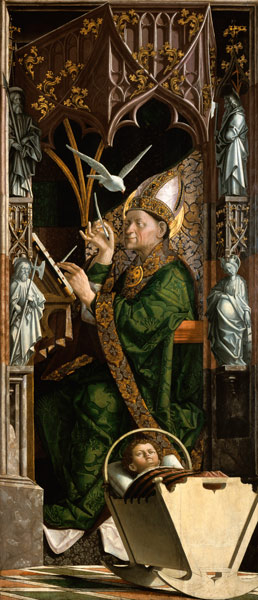
Michael Pacher was a painter and sculptor from Tyrol active during the second half of the fifteenth century. He was one of the earliest artists to introduce the principles of Renaissance painting into Germany. Pacher was a comprehensive artist with a broad range of sculpting, painting, and architecture skills producing works of complex wood and stone. He painted structures for altarpieces on a scale unparalleled in North European art.
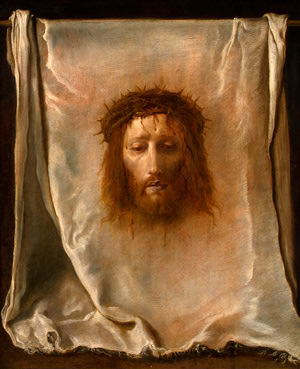
Andachtsbilder is a German term often used in English in art history for Christian devotional images designed as aids for prayer or contemplation. The images "generally show holy figures extracted from a narrative context to form a highly focused, and often very emotionally powerful, vignette".
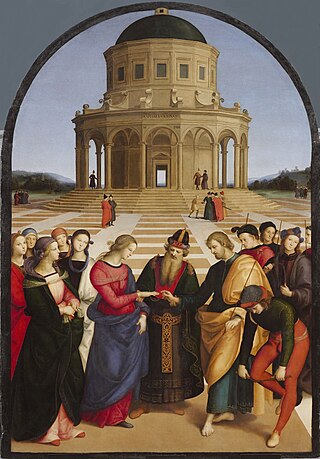
Italian Renaissance painting is the painting of the period beginning in the late 13th century and flourishing from the early 15th to late 16th centuries, occurring in the Italian Peninsula, which was at that time divided into many political states, some independent but others controlled by external powers. The painters of Renaissance Italy, although often attached to particular courts and with loyalties to particular towns, nonetheless wandered the length and breadth of Italy, often occupying a diplomatic status and disseminating artistic and philosophical ideas.
The decade of the 1470s in art involved some significant events.
The decade of the 1460s in art involved some significant events.

The San Zeno Altarpiece is a polyptych altarpiece by the Italian Renaissance painter Andrea Mantegna created around 1456–1459. It remains in situ in the Basilica di San Zeno, the main church of the Northern Italian city of Verona. Mantegna's style mixes Greco-Roman classical themes along with Christian subjects in this altarpiece. The central panel, along with the three paintings that comprise the predella, were taken in 1797 by the French. While the main, central scene was returned by the French to Verona in 1815, the three predella paintings in Verona today are copies, since the original ones remain in France at the Louvre (Crucifixion) and in the Musée des Beaux-Arts in Tours. The paintings are made with tempera on panel; not oil as mistakenly identified in one source.
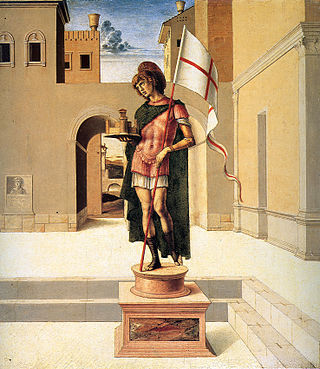
Saint Terence is the patron saint of Pesaro. According to tradition, he was from Pannonia and fled to the Adriatic coast to escape the persecution of Christians under Decius. His corpse was eventually thrown into a gorge near some hot springs, near Pesaro. The place of his martyrdom was considered to be the area called the Apsella di Montelabbate, near the Abbey of San Tomaso in Foglia. This area contains sulphurous springs, and locally they are called the l'Acqua di S. Terenzio.

The Martinengo Altarpiece is a painting by the Italian High Renaissance painter Lorenzo Lotto, finished in 1516. It is housed in the church of Santi Bartolomeo e Stefano in Bergamo in northern Italy.

The Pinacoteca del Castello Sforzesco is an art gallery in the museum complex of the Sforza Castle in Milan, Italy.

Pietà or The Dead Christ Supported by the Virgin Mary and St John the Evangelist is a c. 1465–1470 tempera-on-panel painting by the Italian Renaissance artist Giovanni Bellini, now in the Pinacoteca di Brera in Milan.

The Saint Vincent Ferrer Altarpiece is a tempera-on-panel painting by Giovanni Bellini, dating to 1464–1470 and still in on the altar dedicated to Saint Vincent Ferrer at Santi Giovanni e Paolo, Venice, for which it was originally commissioned. Ferrer was a Spanish Dominican who had only been canonised in 1455 and his order was continuing to promote his cult.

Resurrection of Christ is a painting by the Italian Renaissance artist Giovanni Bellini. The painting is estimated to be created sometime between 1475 and 1479. The painting was created on poplar wood, then transferred to canvas. The Resurrection of Christ's dimensions are in total 148 x 128 cm.
